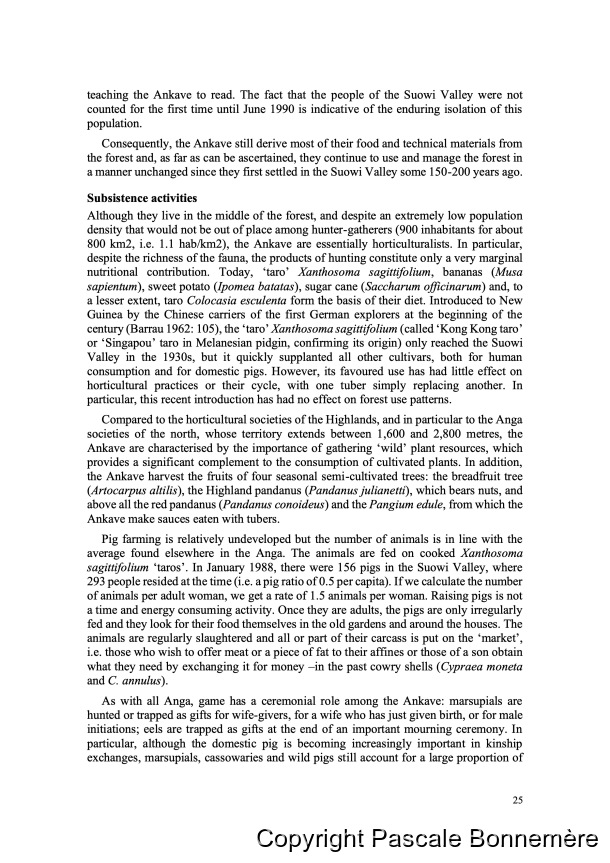|
|  [Note: this transcription was produced by an automatic OCR engine]
teaching the Ankave to read. The fact that the people of the Suowi Valley were not
counted for the first time until June 1990 is indicative of the enduring isolation of this
population.
Consequently, the Ankave still derive most of their food and technical materials from
the forest and, as far as can be ascertained, they continue to use and manage the forest in
a manner unchanged since they first settled in the Suowi Valley some 150-200 years ago.
Subsistence activities
Although they live in the middle of the forest, and despite an extremely low population
density that would not be out of place among hunter-gatherers (900 inhabitants for about
800 km2, 1.e. 1.1 hab/km2), the Ankave are essentially horticulturalists. In particular,
despite the richness of the fauna, the products of hunting constitute only a very marginal
nutritional contribution. Today, ‘taro’ Xanthosoma sagittifolium, bananas (Musa
sapientum), sweet potato (/pomea batatas), sugar cane (Saccharum officinarum) and, to
a lesser extent, taro Colocasia esculenta form the basis of their diet. Introduced to New
Guinea by the Chinese carriers of the first German explorers at the beginning of the
century (Barrau 1962: 105), the ‘taro” Xanthosoma sagittifolium (called ‘Kong Kong taro”
or ‘Singapou” taro in Melanesian pidgin, confirming its origin) only reached the Suowi
Valley in the 1930s, but it quickly supplanted all other cultivars, both for human
consumption and for domestic pigs. However, its favoured use has had little effect on
horticultural practices or their cycle, with one tuber simply replacing another. In
particular, this recent introduction has had no effect on forest use patterns.
Compared to the horticultural societies of the Highlands, and in particular to the Anga
societies of the north, whose territory extends between 1,600 and 2,800 metres, the
Ankave are characterised by the importance of gathering ‘wild’ plant resources, which
provides a significant complement to the consumption of cultivated plants. In addition,
the Ankave harvest the fruits of four seasonal semi-cultivated trees: the breadfruit tree
(Artocarpus altilis), the Highland pandanus (Pandanus julianetti), which bears nuts, and
above all the red pandanus (Pandanus conoideus) and the Pangium edule, from which the
Ankave make sauces eaten with tubers.
Pig farming is relatively undeveloped but the number of animals is in line with the
average found elsewhere in the Anga. The animals are fed on cooked Xanthosoma
sagittifolium ‘taros’. In January 1988, there were 156 pigs in the Suowi Valley, where
293 people resided at the time (1.e. a pig ratio of 0.5 per capita). Ifwe calculate the number
of animals per adult woman, we get a rate of 1.5 animals per woman. Raising pigs is not
a time and energy consuming activity. Once they are adults, the pigs are only irregularly
fed and they look for their food themselves in the old gardens and around the houses. The
animals are regularly slaughtered and all or part of their carcass is put on the ‘market’,
1.e. those who wish to offer meat or a piece of fat to their affines or those of a son obtain
what they need by exchanging it for money -in the past cowry shells (Cypraea moneta
and C. annulus).
As with all Anga, game has a ceremonial role among the Ankave: marsupials are
hunted or trapped as gifts for wife-givers, for a wife who has just given birth, or for male
initiations; eels are trapped as gifts at the end of an important mourning ceremony. In
particular, although the domestic pig is becoming increasingly important in kinship
exchanges, marsupials, cassowaries and wild pigs still account for a large proportion of
25
�
|